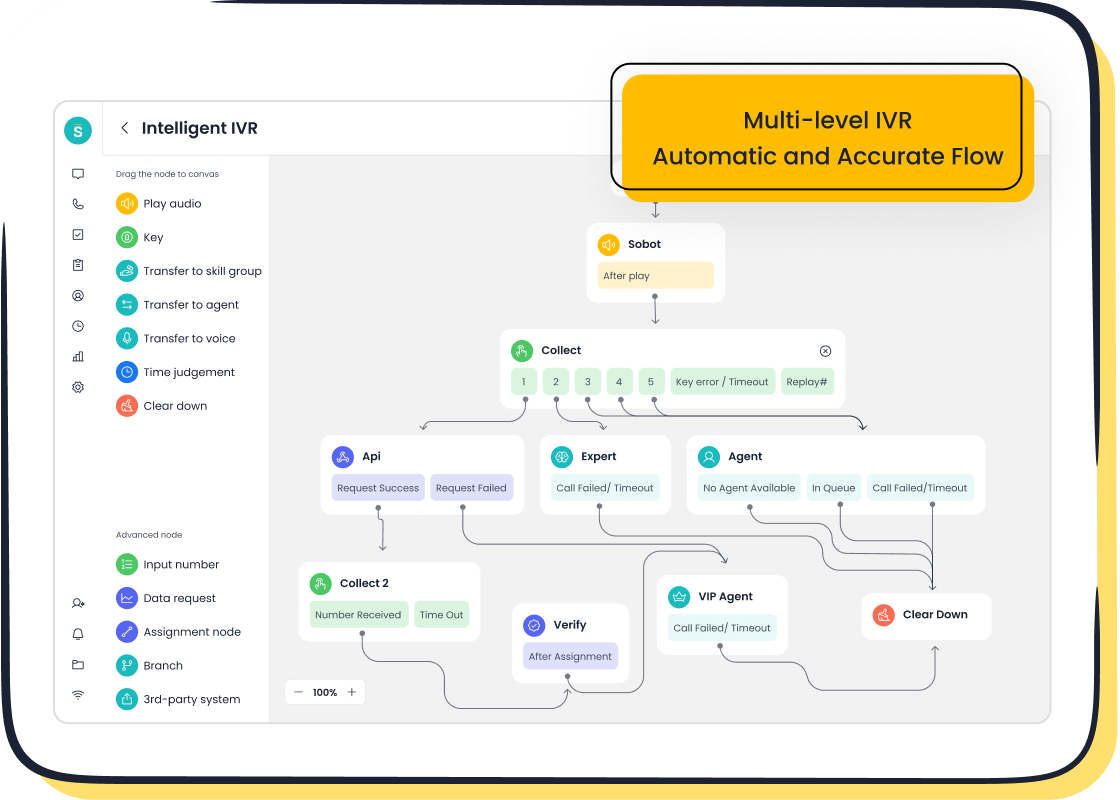Developing Top Customer Service Qualities for Success

Customer service is all about creating trust, meeting customer expectations, and leaving a lasting impression. To achieve this, focusing on three important qualities of customer service—empathy, communication, and problem-solving—is essential. These qualities don’t just improve customer satisfaction; they also drive your professional growth.
When you develop good service skills, you empower yourself to handle challenges confidently. For example:

- Employees with the right training and tools, like Sobot's Voice/Call Center, can resolve issues faster.
- Effective communication boosts morale and efficiency, ensuring happier customers.
Strong customer service skills build trust and loyalty, making you indispensable in your role.
Empathy: Building Genuine Customer Connections

What Is Empathy in Customer Service?
Empathy in customer service is your ability to understand and share the feelings of your customers. It’s about stepping into their shoes and seeing the world from their perspective. Whether a customer is frustrated about a delayed delivery or excited about a new product, empathy allows you to connect with them on a human level. This connection builds trust and makes customers feel valued, which is the foundation of a great customer experience.
Empathy isn’t just about listening; it’s about responding in a way that shows you genuinely care. For example, if a customer expresses frustration, saying, “I can see why this situation is upsetting for you” can make a world of difference. It’s not just a skill—it’s a mindset that transforms interactions into meaningful connections.
Why Empathy Is One of the Three Important Qualities of Customer Service
Empathy is a game-changer in customer service. Why? Because it directly impacts how customers perceive your brand. Studies show that empathetic interactions enhance customer satisfaction and loyalty. When customers feel understood, they’re more likely to return and recommend your services to others.
Did you know? Companies with high empathy levels see increased customer satisfaction, loyalty, and even financial performance. Research shows empathetic companies grow their monetary value more than twice as much as less empathetic ones.
Empathy also helps in conflict resolution. Imagine a customer upset about a billing error. An empathetic response like, “I understand how this could be frustrating. Let me fix this for you right away,” can de-escalate the situation and turn a negative experience into a positive one. In a competitive marketplace, empathy isn’t just nice to have—it’s essential for standing out.
Steps to Cultivate Empathy in Customer Interactions
Building empathy takes practice, but it’s worth the effort. Here are some actionable steps to help you develop this critical skill:
- Active Listening: Pay full attention to what the customer is saying. Avoid interrupting and show that you’re engaged by nodding or using affirming phrases like, “I understand.”
- Ask Open-Ended Questions: Instead of yes-or-no questions, ask things like, “Can you tell me more about the issue?” This encourages customers to share their concerns fully.
- Acknowledge Emotions: Recognize and validate the customer’s feelings. For example, say, “I can see why this would be upsetting.”
- Personalize Your Responses: Use the customer’s name and reference specific details they’ve shared. This makes the interaction feel more personal and less robotic.
- Practice Patience: Some customers may need more time to explain their issues. Be patient and give them the space to express themselves.
Empathy isn’t just about what you say—it’s also about how you say it. Your tone of voice, body language, and even the words you choose can convey genuine care and understanding.
How Sobot's Omnichannel Solution Supports Empathy in Customer Service
Empathy becomes even more powerful when paired with the right tools. Sobot’s Omnichannel Solution is designed to help you deliver empathetic and personalized service across all customer touchpoints. Here’s how:
| Feature | Empathy-Boosting Benefit |
|---|---|
| Unified Workspace | Gives agents a complete view of customer history, enabling personalized and empathetic responses. |
| AI-Driven Chatbots | Handles repetitive queries, freeing agents to focus on complex, emotion-driven interactions. |
| Multi-Channel Support | Ensures customers can reach you through their preferred platform, enhancing their experience. |
| Real-Time Analytics | Provides insights into customer sentiment, helping agents tailor their approach. |
For example, Samsung used Sobot’s solution to unify its communication channels and improve data connectivity. This allowed their agents to access comprehensive customer histories, reducing repetitive questioning and enabling more empathetic interactions. The result? A 97% customer satisfaction rate and a 30% boost in agent efficiency.
By integrating Sobot’s Omnichannel Solution, you can foster proactive engagement and deliver the kind of customer experience that builds trust and loyalty. Empathy isn’t just a skill—it’s a strategy, and with the right tools, you can master it.
Communication: The Cornerstone of Customer Satisfaction
Defining Effective Communication in Customer Service
Effective communication is the backbone of excellent customer service. It’s not just about exchanging words; it’s about ensuring your message is clear, concise, and understood. When you communicate effectively, you build trust, resolve issues faster, and create a positive experience for your customers.
In fact, poor communication costs businesses nearly $4 billion annually in the U.S. alone. This highlights how crucial it is to get it right. Whether you’re explaining a product feature or addressing a complaint, clear communication ensures customers feel heard and valued. It’s the difference between a satisfied customer and one who walks away frustrated.
Verbal and Non-Verbal Communication Techniques
Did you know that communication isn’t just about what you say? Research by Albert Mehrabian shows that 55% of communication comes from non-verbal cues, 38% from vocal elements, and only 7% from spoken words. This means your tone, facial expressions, and body language often speak louder than your words.
Here are some techniques to master both verbal and non-verbal communication:
- Verbal: Use simple, positive language. Avoid jargon and tailor your words to the customer’s level of understanding.
- Non-Verbal: Maintain eye contact, use open gestures, and smile when appropriate. These small actions can make customers feel more comfortable and connected.
By combining these techniques, you can ensure your message is not only heard but also felt.
Active Listening: A Key Customer Service Skill
Listening is more than just hearing words. Active listening involves fully concentrating, understanding, and responding thoughtfully. It’s a skill that makes customers feel valued and understood. Research shows that 60% of business issues stem from ineffective communication, emphasizing the importance of listening in customer interactions.
To practice active listening:
- Focus entirely on the customer without distractions.
- Paraphrase their concerns to show you understand.
- Respond with empathy and offer solutions tailored to their needs.
When customers feel heard, they’re more likely to trust you and remain loyal.
Leveraging Sobot's Voice/Call Center for Clear and Effective Communication
Sobot’s Voice/Call Center takes communication to the next level. It equips you with tools to ensure every interaction is seamless and effective. Features like intelligent IVR and smart call routing help you connect customers to the right agent quickly. The unified workspace provides a complete view of customer history, enabling personalized and clear communication.
Performance metrics like customer satisfaction scores and call resolution rates improve significantly with Sobot’s tools. For example, Samsung achieved a 97% customer satisfaction rate by using Sobot’s platform to streamline communication and enhance agent efficiency. With Sobot, you can deliver the kind of service that keeps customers coming back.
Problem-Solving: Turning Challenges into Opportunities

The Importance of Problem-Solving Abilities in Customer Support
Every customer interaction is unique, and challenges are bound to arise. This is where your problem-solving abilities shine. When you approach issues with a solution-focused mindset, you not only resolve conflicts but also create opportunities to strengthen customer relationships.
Think about it—when a customer faces a problem, they’re looking for someone who can listen, understand, and act. Your ability to identify the root cause and provide tailored solutions can turn a frustrated customer into a loyal advocate. For example, feedback about children’s sneakers with poor traction led one company to design a safer, more effective product line. This not only solved the issue but also opened doors to new business opportunities.
Effective problem-solvers don’t just fix issues; they innovate. They see challenges as chances to learn, improve, and grow. By adopting this mindset, you can transform even the toughest situations into success stories.
Steps to Develop Strong Problem-Solving Skills
Building strong problem-solving skills takes practice and a structured approach. Here’s how you can sharpen your ability to tackle challenges effectively:
- Define the Problem: Take time to understand the issue thoroughly. Research and ask questions to uncover the root cause.
- Brainstorm Solutions: Think creatively. Generate multiple ideas, even if some seem unconventional.
- Analyze Options: Evaluate each solution carefully. Consider the pros and cons to make informed decisions.
- Manage Risks: Anticipate potential downsides and plan accordingly.
- Decide and Act: Choose the best solution and implement it confidently.
- Reflect and Learn: After resolving the issue, reflect on what worked and what didn’t. Use these insights to improve your approach next time.
Even simple activities like solving puzzles or getting a good night’s sleep can boost your problem-solving ability. Rested minds are more creative and better equipped to handle challenges.
Real-Life Examples of Problem-Solving in Action
Real-world examples show how effective problem-solving can lead to measurable success. Let’s look at some case studies:
| Case Study | Benefits Illustrated | Quantitative Data |
|---|---|---|
| Company A | Improved customer satisfaction | 30% increase in NPS |
| Company B | Reduced response time | 50% faster resolution |
| Company C | Increased sales | 20% growth in revenue |
These examples highlight how addressing customer challenges effectively can lead to tangible results. Whether it’s improving satisfaction scores or boosting revenue, problem-solving delivers real value. By focusing on solutions, you can achieve similar outcomes in your role.

How Sobot's AI-Powered Tools Enhance Problem-Solving Efficiency
Sobot’s AI-powered tools are designed to make problem-solving faster and more efficient. Here’s how they help:
- Streamlined Processes: Sobot’s intelligent IVR and smart call routing ensure customers reach the right agent quickly.
- Data-Driven Insights: Real-time analytics provide valuable information about customer behavior, helping you identify patterns and anticipate issues.
- Enhanced Team Performance: Features like unified workspaces and AI-powered voicebots free up agents to focus on complex problems.
- Improved Response Times: With tools like bulk outbound tasks and automated workflows, you can resolve issues faster and more effectively.
For instance, Samsung used Sobot’s platform to unify its communication channels and improve data connectivity. This allowed their agents to access complete customer histories, reducing repetitive questioning and enabling quicker resolutions. The result? A 97% customer satisfaction rate and a 30% boost in efficiency.
By leveraging Sobot’s tools, you can enhance your problem-solving ability, deliver exceptional service, and turn challenges into opportunities for growth.
Adaptability: Thriving in a Dynamic Customer Service Environment
Why Adaptability Is Crucial for Customer Service Professionals
Adaptability is the secret weapon for thriving in today’s fast-paced customer service world. Every day brings new challenges—whether it’s a sudden spike in inquiries, a shift in customer expectations, or the introduction of new tools. Being adaptable means you can adjust quickly and stay effective no matter what comes your way.
Why is this skill so important? Studies show that adaptable professionals tend to have a positive outlook, empathy, and a willingness to learn. These traits help you manage change and master new skills in a rapidly evolving environment. For customer service, this could mean learning to use advanced tools like Sobot’s Unified Workspace or staying updated on industry trends to meet customer needs. With 93% of customers expecting higher service standards than ever before, adaptability isn’t just helpful—it’s essential.
Strategies to Build Adaptability in the Workplace
Building adaptability takes effort, but it’s worth it. Start by creating a mindset that embraces change. Here are some strategies to help you grow:
- Learn Continuously: Take advantage of training programs, workshops, or online courses. Sobot’s AI-powered tools, for example, offer intuitive features that make learning new systems easier.
- Seek Feedback: Regularly ask customers and colleagues for input. Use surveys or direct conversations to identify areas for improvement.
- Stay Organized: Good time management helps you handle unexpected changes without feeling overwhelmed.
- Collaborate: Work closely with your team. Sharing knowledge and experiences can help everyone adapt faster.
By practicing these strategies, you’ll not only improve your adaptability but also boost your confidence in handling change.
Handling Unexpected Customer Scenarios with Confidence
Unexpected situations are part of the job. A customer might call with a unique issue, or a system outage could disrupt your workflow. How you respond makes all the difference. Start by acknowledging the customer’s feelings. For example, saying, “I understand how frustrating this must be,” can instantly de-escalate tension.
Next, gather all the details you need to understand the problem. Be transparent about what went wrong and offer a clear solution. Tools like Sobot’s Voice/Call Center can help by providing real-time customer data and smart call routing, ensuring you’re prepared to act quickly. Finally, follow up to show you care about their experience. These steps not only resolve the issue but also strengthen customer trust.

Examples of Adaptability Using Sobot's Unified Workspace
Sobot’s Unified Workspace is a game-changer for adaptability. It consolidates customer data from multiple channels into one platform, making it easier to switch between tasks and handle unexpected scenarios. For instance, if a customer reaches out via email and then follows up on social media, the Unified Workspace ensures you have all the context in one place. This saves time and reduces errors.
Samsung’s success story highlights this perfectly. By using Sobot’s solutions, their agents adapted to high inquiry volumes while maintaining a 97% customer satisfaction rate. The platform’s seamless integration and real-time analytics allowed them to stay flexible and efficient, even during peak times. With tools like these, you can adapt to any situation with confidence.
Resilience: Maintaining Positivity Under Pressure
Understanding Resilience in Customer Service Roles
Resilience is your ability to bounce back from challenges and maintain a positive outlook, even under pressure. In customer service, this means staying calm and composed when dealing with difficult customers or unexpected situations. It’s not just about enduring stress but thriving in demanding environments.
Studies show that resilience directly impacts job satisfaction and positivity. For example:
| Finding | Description |
|---|---|
| Stress Mitigation | Resilience reduces stress, leading to higher job satisfaction. |
| Resilience and Positivity | Strong resilience correlates with higher positivity and perceived control. |
When you develop resilience, you’re better equipped to handle high-pressure roles while maintaining a positive attitude. This not only benefits you but also creates a better experience for your customers.
Techniques to Build Emotional Resilience
Building emotional resilience takes practice, but it’s achievable with the right strategies. Here are some proven techniques:
- Engage in activities that boost employee morale, like team-building exercises.
- Empower yourself to make decisions that improve customer interactions.
- Track and analyze customer feedback to identify areas for improvement.
- Create pre-approved solutions for common customer issues to reduce stress.
Companies that prioritize employee engagement see a 75% higher engagement rate compared to those that don’t. This shows how fostering a supportive environment can strengthen your patience and resilience.
Managing Stress and Preventing Burnout
Stress is inevitable in customer service, but burnout doesn’t have to be. Managing stress effectively can help you stay energized and focused. Start by setting boundaries to separate work from personal life. Take short breaks during your shift to recharge.

Using tools like Sobot’s Unified Workspace can also reduce stress. By consolidating customer data into one platform, it minimizes repetitive tasks and allows you to focus on meaningful interactions. This not only improves efficiency but also helps you maintain a positive mindset.
Inspiring Stories of Resilient Customer Service Professionals
Real-life examples show how resilience can transform customer service. In one study, implementing an emergency plan reduced waiting times by 96% for yellow codes and 75% for green codes. This highlights how preparation and adaptability can lead to remarkable outcomes.
Similarly, Samsung achieved a 97% customer satisfaction rate by using Sobot’s solutions to streamline operations. Their agents handled high-pressure situations with confidence, proving that resilience, paired with the right tools, can drive success.
Empathy, communication, and problem-solving are the cornerstones of exceptional customer service. Together, they create meaningful connections, resolve issues effectively, and drive customer satisfaction. These qualities don’t just benefit customers—they also help you grow professionally.
Continuous learning plays a vital role in mastering these skills. Did you know 80% of customers value their experience as much as the product itself? Companies that invest in training see happier employees and better performance. Tools like Sobot's Voice/Call Center make this journey easier by streamlining communication and providing real-time insights.
Start small. Practice active listening, refine your communication, and embrace challenges as opportunities. With dedication and the right tools, you can excel in your role and deliver the kind of service that keeps customers coming back.
FAQ
What is the most important skill in customer support?
Empathy is key. It helps you connect with customers on a personal level. When customers feel understood, they’re more likely to trust your customer support and stay loyal.
How can I improve my customer support communication skills?
Practice active listening and use simple, clear language. Tools like Sobot’s Voice/Call Center can help streamline communication, making it easier to deliver excellent customer support.
Why is adaptability important in customer support?
Customer needs change constantly. Adaptability ensures you can handle unexpected situations confidently. Sobot’s Unified Workspace helps you stay flexible by organizing customer data in one place.